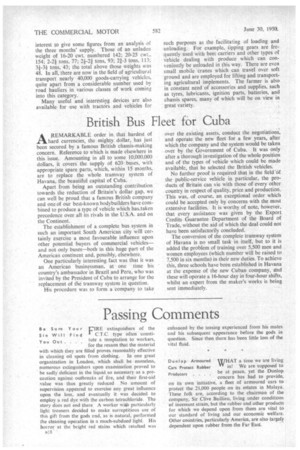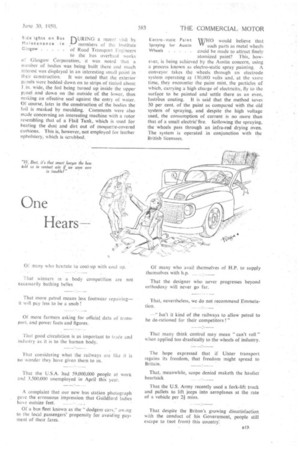Passing Comments
Page 36

Page 37

If you've noticed an error in this article please click here to report it so we can fix it.
Be Sure Your FIRE extinguishers of the Sin Will Find I C.T.C. type often consti You Out. . tute a temptation to workers,
for the reason that the material with which they are filled proves reasonably effective in cleaning oil spots from clothing. In one great organization in London, which shall be nameless, numerous extinguishers upon examination proved to be sadly deficient in the liquid so necessary as a precaution against outbreaks of fire, and their first-aid .value was thus greatly reduced No amount of supervision appeared to exercise any great influence upon the loss, and eventually it was decided to employ a red dye with the carbon tetrachloride. The story does not end there A worker with particularly light trousers decided to make surreptitious use of this gift from the gods and, as is .natural, performed the cleaning operation in a much-subdued light. His horror at the bright red stains which resulted was enhanced by the teasing experienced from his mates and his subsequent appearance before the gods in question. Since then there has been little loss of the vital fluid.
Dunlop Armoured WHAT a time we are living Cars Protect Rubber " in! We are supposed to Producers . . . . be at peace, yet the Dunlop concern has had to provide, on its own initiative, a fleet of armoured cars to protect the 21,000 people on its estates in Malaya. These folk are, according to the chairman of the company, Sir Clive Baillieu, living under conditions of incessant strain, but the rubber and other products for which we depend upon from them are vital to our standard of living and our economic welfare. Other countries, particularly America, are also largely dependent upon rubber from the Far East.
DURING a recent i sit by members of the Institute of Road Transport Engineers to the bus overhaul works of Glasgow Corporation, it was noted that a number of bodies was being built there and much interest was displayed in an interesting small point in their construction. It was noted that the exterior panels were bedded down on to strips of tinfoil about I in. wide,, the foil being turned up inside the upper panel and down on theoutside of the lower, thus making an effective seat against the entry of water. Of course, latei in the construction of the bodies the foil is masked by moulding. -Comments were also made concerning an interesting machine with a rotor resembling that of a Flail Tank, which is used for beating the dust and dirt out of moquette-covered cuSilions. This is, however, not employed for leather upholstery, which is Scrubbed.
Side ights on Bus Mintenance in Gasgow
E:ectro static Paint WHO would believe that Spraying for Austin " such pans as metal wheels Wheels could be made to attract finely atomized paint? This, however, is being achieved by the Austin concern, using a process known as electro-static spray painting. A conveyor takes the wheels through an electrode system operating at 130,000 volts and, at the same time, they encounter the paint mist, the particles of which, carrying a high charge of electricity, fly to the surface to be painted and settle there as an even, lustrOus coating. It is said that the method Saves 50 per cent, of the paint as compared with the old system of spraying, and despite the high voltage used, the consumption of current is no more than that of a small electric' fire. hollowing the spraying, the wheels pass through an infra-red drying oven. The system is operated in conjunction with the British licensees.




























































































































